2) Marine Ecology Department, National Marine Environmental Monitoring Center, Dalian 116023, China;
3) School of Environmental Science and Engineering, Tianjin University, Tianjin 300072, China4) Third Institute of Oceanography, Ministry of Natural Resources, Xiamen 361005, China;
4) Third Institute of Oceanography, Ministry of Natural Resources, Xiamen 361005, China
The Bohai Rim region has experienced rapid urbanization and industrialization in recent years, causing its nearby estuaries and coastal areas facing severe riverine pollution pressures. The total gross domestic product (GDP) contributed by the surrounding Bohai zone increased from 82.9 billion to 13.2 trillion RMB from 1978 to 2012, and the population density and GDP were 3.4 times and 4.7 times higher than the national average value, respectively (National Bureau of Statistics of China). The high intensive coastal human exploitation carried numerous chemical pollutants into Bohai Sea. Especially, the Bohai Sea is a semi-closed inland sea, which has limited water-exchange ability compared with open sea area. Contaminants in the Bohai Sea are considered to be intensified due to the relative long time of seawater flushing, which was estimated to be 1181 d. As a result, the Bohai Sea faces severe pollution problems, which pose a constant threat to the integrity and function of ecosystems. The Chinese government has paid much attention and took several actions to the environmental protection of Bohai Sea, but these programs did not gain satisfy achievements. Recently, Ministry of Ecology and Environment has released a new governance strategic framework named 'Action plan for the Bohai comprehensive management', which is one of the seven landmark major battle against pollution prevention and control in China. An update comprehensive investigation and assessment of contaminants in the Bohai Sea, especially the coastal region, will give important information for this government project.
Heavy metals are naturally present in the environment but increased through industrial activities as pollutants. In the past decades, metal contamination in the coastal waters has attracted global attention owing to its environmental toxicology, wild distribution, persistence and bioaccumulation characteristics. Heavy metals are notorious pollutants widely presented in marine ecosystems. They are transported and transformed by means of natural and anthropogenic sources such as land-based input and atmospheric deposition. These metals could have negative effects on the inhabitant organisms and transfer through the food chain to human beings eventually. In the coastal waters, the concentrations of heavy metals largely determined by terrestrial pollutant loadings, water volume and the water exchange ability with the open ocean.
Ecological risk assessment (ERA) evaluates the likelihood of adverse effects caused by stressors on ecological components, aiding subsequent environmental risk management and decision making. Adverse ecological effects encompass a wide range of disturbances ranging from mortality in an individual organism to a loss of ecosystem function. US Environmental Protection Agency (EPA) defined the generic framework and guidelines of ERA, in which hazard identification, exposure and dose-response assessments, and the risk characterization were defined. USEPA established the Ecotoxicology Database (ECOTOX), providing comprehensive information on adverse effects of single chemical stressors to ecologically species. ECOTOX includes more than 780000 test records covering 12000 aquatic and terrestrial species and 11000 chemicals. To apply the experimental data to develop reasonable environmental standards for the entire ecosystem, interspecies correlation estimation (ICE) models and species sensitivity distribution (SSD) methods have gained wide application during the past decades (Wheeler et al., 2002; de Vries et al., 2008). The aim of SSD is to calculate the concentration at which a specified proportion of species will be affected, referred to as the hazardous concentration (HC) for p (%) of species (HCp). The most frequently estimated HCs are the HC5, at which 95% of species are not affected. Xin et al. (2015) applied SSD curves to compare the sensitivities of aquatic organisms to six typical heavy metals, and the results indicated that HC5 values were in the descending order of Zn > Pb > Cr > Cd > Hg > Cu. Meanwhile, the percentage of affected species associated with a certain concentration can be used to assess the toxicity of a stressor and the potential ecological risk.
This study aimed to describe the spatial distribution of nutrients (DIN and DIP) and heavy metals (Cd, Pb, Zn, Cu, Cr, As and Hg) in the coastal Bohai Sea. The results obtained will provide valuable information for future policy-making decision regarding control of nutrients and heavy metal contamination and restoration of coastal environment.
2 Materials and Methods 2.1 Study Area and Sample CollectionGenerally, the Bohai Sea consists of four major water bodies, including Liaodong Bay, Bohai Bay, Laizhou Bay and central Bohai Sea. A total of 150 sample sites from seven regions were designed over the coastal area of Bohai Sea (Fig. 1). These regions included Changxingdao Island (27 sites), Shuangtaizi Estuary (27 sites), Jinzhou Bay (12 sites), Luanhekou Estuary (24 sites), Bohai Bay (20 sites), Yellow River Estuary (20 sites) and Laizhou Bay (20 sites), which represented important estuarine and coastal areas around Bohai Sea. The surface seawater samples were collected from 0.5 m below the surface at each site with 5 L Niskin bottles in 2017. The aliquots of the surface seawater sample were filtered through a 0.45 μm microporous filter membrane under vacuum to dissolve the samples and stored at 4℃ for further analysis.
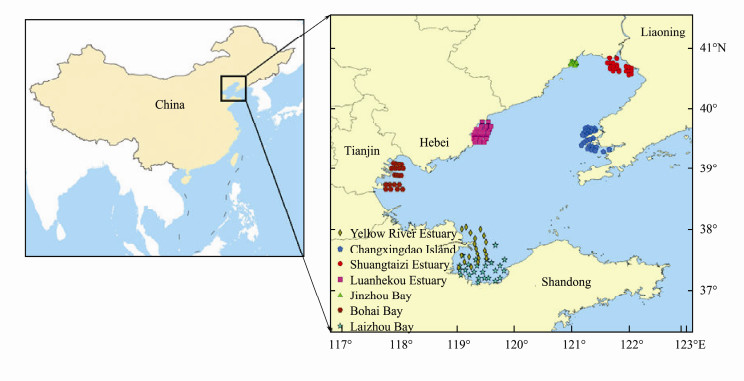
|
Fig. 1 Location of sampling sites around the coastal Bohai Sea. |
All digestive processes were referred to China National Standards (GB 17378-2007). The concentrations of NO3-N, NO2-N, NH4-N, and PO4-P in seawater were determined colorimetrically (Alpha-1860; Shanghai Lab-Spectrum Instruments Co., Shanghai, China) according to the methods described by Grasshoff (1983). The detection limits for NH4-N, NO3-N, NO2-N, and PO4-P were 4, 6, 3, and 1.4 µg L−1, respectively. All measurements were completed within 24 h of sampling. The dissolved inorganic nitrogen (DIN) was determined as intergrated single value of three nitrogen sources (c(NO3−) + c(NH4+) + c(NO2−)) as nitrite and ammonium were negligible compared to nitrate.
The concentrations of the dissolved heavy metals were determined by inductively coupled plasma mass spectrometry (ICP-MS, Thermo X series) for Cd, Pb, Zn, Cu, and Cr, whereas the contents of Hg and As were determined using an atomic fluorescence spectrometer (AFS-920). The detection limits were 0.01, 0.03, 3.1, 0.2, 0.5, 0.5, and 1.2 µg L−1 for Cd, Pb, Zn, Cu, Cr, Hg, and As in seawater, respectively.
2.3 Quality ControlThe analytical data quality was guaranteed through the implementation of laboratory quality assurance and quality control methods, including the use of standard operation procedures, calibration with standards, analysis of reagent blanks, recovery of known additions and analysis of replicates. All analyses were carried out in triplicate, and the results were expressed as the mean. Analytical precision was in good agreement, generally better than 5.0% relative standard deviation and the percentage recoveries of chemical analysis were between 90% and 110%.
2.4 Data AnalysisThe eutrophication assessment was based on eutrophication index (E) using the following formula:
| $ E = \frac{{{\rm{COD}} \times {\rm{DIN}} \times {\rm{DIP}} \times {{10}^6}}}{{4500}}, $ |
where COD (µg L−1), DIN (µg L−1) and DIP (µg L−1) are the concentrations of chemical oxygen demand, dissolved inorganic nitrogen (NO2-N + NO3-N + NH4-N) and dissolved inorganic phosphorus, respectively. Three levels of eutrophication (E≥ 1) were defined: 1 ≤ E≤ 3 indicated mild eutrophication, 3 < E≤ 9 indicated moderate eutrophication, and E > 9 indicated severe eutrophication.
Ecologcial risk assessment method used in this study was generally followed by Wang et al. (2018). Briefly, the EC50 or LC50 data for the metals were downloaded from the US EPA ECOTOX database for three groups of marine animals (crustacean, fish and mollusc). We selected ecotoxicity data for inorganic forms of heavy metal exposed experiment in seawater environment, and at least eight data points were required to construct ICE models and SSD curves. Due to the limited reported ecotoxicity data of Cd and Cr, we constructed SSD curves for Hg, Pb, As, Cu and Zn. The calculation of SSDs was performed using SSD generator using the log-normal model (US EPA). Based on the SSD curves and monitoring data, the ecological risks (Ps) were calculated and the proportions of marine organisms expected to be affected at prescribed concentrations were evaluated for crustacean, fish and mollusc, respectively in the Bohai Sea. In addition to the risks induced by a single metal, the multi-substance potential affected fraction (msPAF) was used to estimate the combined effects of five metals as follows (He et al., 2014):
| $ \begin{array}{*{20}{c}} {{\rm{msPAF = 1 - (1 - }}{{\rm{P}}_{{\rm{Hg}}}}{\rm{) - (1 - }}{{\rm{P}}_{{\rm{Pb}}}}{\rm{) - (1 - }}{{\rm{P}}_{{\rm{As}}}}{\rm{) - }}}\\ {{\rm{(1 - }}{{\rm{P}}_{{\rm{Cu}}}}{\rm{) - (1 - }}{{\rm{P}}_{{\rm{Zn}}}}{\rm{), }}} \end{array} $ |
where PHg, PPb, PAs, PCu and PZn are the ecological risk of each metal for marine organisms.
3 Results and Discussion 3.1 Nutrient ConcentrationsThe results of DIN and PO4-P concentrations in surface waters of seven coastal regions of Bohai Sea are shown in Fig. 2. The mean DIN concentrations ranged from 60.89 µg L−1 to 392.53 µg L4−1 in the seven investigated regions, while PO-P concentrations ranged from 4.40 µg L−1 to 20.15 µg L−1. DIN concentrations followed the order: Bohai Bay > Shuangtaizi Estuary > Laizhou Bay > Yellow River Estuary > Jinzhou Bay > Changxingdao Island > Luanhekou Estuary, while PO4-P concentrations followed the order: Bohai Bay > Shuangtaizi Estuary > Changxingdao Island > Yellow River Estuary > Laizhou Bay > Jinzhou Bay > Luanhekou Estuary. According to Seawater Quality of China (GB 3097-1997), the DIN concentration of 47.3% sites (71/150) were worse than the Grade-Ⅰ value (Table 1), which indicated DIN were the main pollutants in the coastal Bohai Sea. This result is consistent with previous studies in the whole Bohai Sea/coastal area. Wang et al. (2009) showed 22.1% of all stations were classified as violating the Grade-Ⅰ concentration for DIN and only 3.9% for PO4-P in the coastal and central area of Bohai Sea. Peng (2015) investigated the concentrations of nutrients (DIN and DIP) in the seawater samples of Bohai Bay between 2007 and 2012, and found that DIN was the main pollutant in the seawater of Bohai Bay, which resulted in a eutrophication risk. The nitrogen contamination has become serious since 1985, and caused a serious of environmental problems (Zhang et al., 2006). Compared with DIN, the PO4-P contamination situation was better, with the concentration of 26.0% sites 39/150 larger than the Seawater Quality Standard Grade-Ⅰ value. Except of Changxingdao Island, the ratios of DIN/PO4-P in the surface seawater of other regions were all several times higher than 16:1, the optimum ratio required by phytoplankton. This results indicated that PO4-P was the main limiting factor for phytoplankton growth in coastal Bohai Sea. Compared with other regions, the relative higher levels of PO4-P in the surface seawater of Bohai Bay could result from the effluent discharge of the chemical plants and dockyards around the coastal areas.
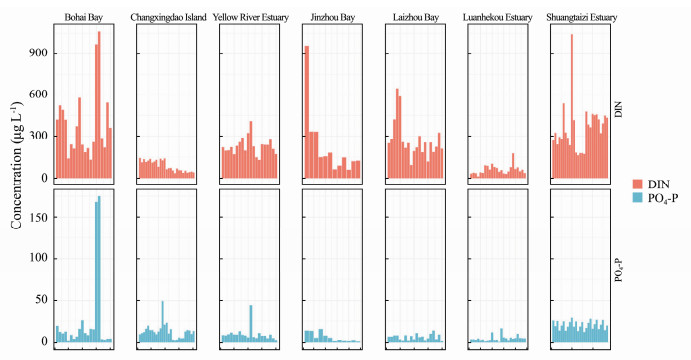
|
Fig. 2 Concentrations of DIN and PO4-P in the surface seawater ofcoastal regions in Bohai Sea. These regions included Changxingdao Island (27 sites), Shuangtaizi Estuary (27 sites), Jinzhou Bay (12 sites), Luanhekou Estuary (24 sites), Bohai Bay (20 sites), Yellow River Estuary (20 sites) and Laizhou Bay (20 sites), which represented important estuarine and coastal areas around Bohai Sea. |
|
|
Table 1 Seawater quality standard of China for the selected items (µg L−1) |
The increase trend in DIN/PO4-P was mainly due to increasing N concentration related to river discharge into Bohai Sea and atmospheric deposition (Zhang et al., 2004). There are a total of 16 rivers carrying large amounts of freshwater discharge and dissolved nutrients into Bohai Sea. For instance, the Yellow River, the second largest river in China, discharging a huge amount of dissolved nutrients, i.e., 71.18 kt year−1 of nitrate and 0.43 kt year−1 of phosphate, contribute more than half of the total river discharges into the Bohai Sea. It was reported that DIN concentrations in rainwater and aerosol over the Bohai Sea were also high, and the source of DIN from atmospheric deposition could not be neglected (Zhang et al., 2004). The increase in DIN concentrations from both river discharge and atmospheric deposition was probably associated with anthropogenic activities (Yang et al., 2018). With the quick development of the economy in China, the rapid urbanization and growth of commercialindustrial activities and the lack of legislative control along the coastal regions have led to a congregation of population and high-density aquaculture and agriculture in the coastal area around the Bohai Sea, resulting in increasing municipal and livestock waste discharges, chemical fertilizer release from farmlands, animal excretion from marine-culture sites, sewage discharge from land, etc., which have been responsible for increasing the DIN input via major rivers into the Bohai Sea. For example, DIN input via the Yellow River was 72.9 × 103 t in 1958, 84.6 × 103 t in 1984, and 92.2 × 103 t in 1993 (Zhang et al., 2004). Although most of the wastewater was treated and met the China effluent criteria, the accumulative total pollutant loading exceeds the environmental selfpurification ability. Therefore, to improve the seawater quality, it's important to strengthen the management of riverine pollutant entry to control the total DIN flux in Bohai Sea.
3.2 Eutrophication AssessmentIn this study, the Eutrophication Index (E) in the coastal Bohai Sea was analyzed according to the concentrations of DIN, PO4-P and COD. The average E in the surface seawater of seven coastal regions ranged from 0.1 to 17.8 (Table 2). The high values occurred in Bohai Bay and Shuangtaizi Estuary, and low values distributed in Luanhekou Estuary and Changxindao Island (Fig. 3). The severe eutrophication in Bohai Bay and Shuangtaizi Estuary has been reported previously. According to previous studies and our results, some hotspot ares, including Bohai Bay, Liaodong Bay and Shuangtaizi Estuary showed severe N eutrophication comparing with other coastal areas by calculating E. Wang et al. (2009) showed that the state of eutrophication was generally mesotrophic in the Bohai Sea, but relatively worse in the coastal area, with the high values occurred in the Bohai Bay and Liaodong Bay. This indicated that the distribution of eutrophic area has not changed in recent years. Considering the fact that Bohai Bay and Liaodong Bay receive large quantities of contaminants from river discharge, the human activities had a large impact on the coastal environment.
|
|
Table 2 Mean concentrations of DIN and PO4-P, DIN/ PO4-P and eutrophication index in the surface seawater of seven coastal regions of Bohai Sea |

|
Fig. 3 Distribution diagram of the eutrophication status of the Bohai Sea based on eutrophication index (E). No eutrophication, E < 1; mild eutrophication, 1 ≤ E ≤ 3; moderate eutrophication, 3 < E ≤ 9; severe eutrophication, E > 9. |
According to Bulletin of Marine Environmental Status of China (2017) issued by the State Oceanic Administration, the eutrophic sea area generally declined in the total sea of China (Bohai Sea, the Yellow Sea, the East China Sea and the South China Sea) in summer from 2011 to 2017 (Fig. 4). The highest eutrophic area occurred in 2012 with a value of 97890 km2. The eutrophic area exhibited a rise first then a decrease trend in the total sea after 2012. Different with the situation of the total sea, the eutrophic area showed a general decrease trend in the Bohai Sea after 2012, and the lowest point occurred in 2017 with a value of 6650 km2. The decreasing concentration trend of nutrients in the Bohai Sea was attributed to the promulgation of environmental protection policy. The government implemented 'Marine Ecological Redline' firstly in the Bohai Sea, which defined > 35% sea area and > 30 natural shoreline as the redline region to be under mandatory and rigorous protection. The ecological 'red line' serves as both a 'bottom line' and a 'lifeline' in safeguarding national ecological safety. Ecological redline regions are expected to help solve the problems of environmental degradation and natural resource depletion and to alleviate the adverse effects of natural disasters (Lin et al., 2016). Additionally, three national marine nature reserves and 18 national marine special protected areas (ocean parks) have been established in the Bohai Sea with a total protected area of 3429 km2. In the 12th Five-Year Plan of China (2011-2015), over two billion RMB was invested in Bohai Rim area to carry out 63 marine ecology restoration projects and seven island protection projects. Thus, the implemented programs of protection and restoration in Bohai Sea likely explains the decreasing trend of nutrient element concentrations.
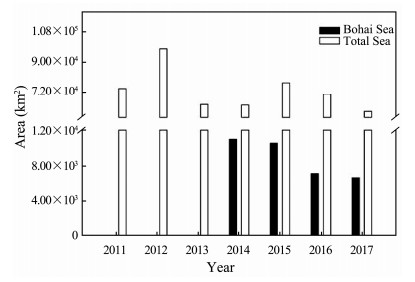
|
Fig. 4 The variation of eutrophic area in the Bohai Sea and total sea of China between 2011 and 2017. |
Though metal contamination is notorious as one of the most serious environmental problems, the amount of metals produced and consumed in China has been increasing with rapid urbanization and industrialization, especially in the coastal waters (Pan and Wang, 2012; Wang et al., 2013). Compared with Yellow Sea, East China Sea and South China sea, the metal contamination in the Bohai Sea was relatively serious (Li et al., 2018; Wang et al., 2018). In this study, the concentrations of heavy metals (Cd, Pb, Zn, Cu, Cr, As and Hg) in the surface seawater were investigated and their spatial variations along the Bohai coastal regions were observed (Table 3). For Pb, about 45% of the sampling sites had concentrations larger than 1.0 μg L−1, which was the Grade-Ⅰ limit by the seawater quality standard of China, but no site exceeded Grade-Ⅱ (5.0 μg L−1). High values distributed in the Changxingdao Island and Bohai Bay. For Zn, the concentration of about 35% the sampling sites exceeded the Grade-Ⅰ limit (20 μg L−1), with two sites worse than Grade-Ⅱ criteria (50 μg L−1). The high values distributed in the Laizhou Bay, Shuangtaizi Estuary and Jinzhou Bay. The average concentration of Zn in the Shuangtaizi Estuary, Laizhou Bay, Jinzhou Bay, Yellow River Estuary, Luanhekou Estuary, Changxingdao Island and Bohai Bay was 29.97 ± 10.03, 26.19 ± 14.20, 18.68 ± 2.48, 16.18 ± 4.76, 13.59 ± 7.28, 11.53 ± 6.89 and 6.08 ± 5.00 μg L−1, respectively. For Hg, the concentrations of about 27% sites had concentrations higher thatn 0.05 μg L−1, which was the Grade-Ⅰ limit. High values occurred in Shuangtaizi Estuary and Laizhou Bay. For Cu, about 80% of the sampling sites had concentrations lower than 5 μg L−1, which is the Grade-Ⅰ limit. The average concentration of Cu in the Changxingdao Island, Shuangtaizi Estuary, Laizhou Bay, Bohai Bay, Jinzhou Bay, Yellow River Estuary and Luanhekou Estuary was 12.40 ± 5.17, 3.81 ± 0.84, 2.74 ± 0.56, 2.24 ± 1.63, 2.08 ± 0.29, 1.83 ± 0.61 and 0.89 ± 0.66 μg L−1, respectively. For Cd, Cr and As, all the sampling sites met Grade-Ⅰ criteria. To sum up, Pb, Zn, Hg and Cu were the main metal pollutants in the coastal waters of the Bohai Sea, and Shuangtaizi Estuary, Changxingdao Island, and Yellow River Estuary were the hot spot region for metal pollution.
|
|
Table 3 Comparison of heavy metals (Cd, Pb, Zn, Cu, Cr, As and Hg) concentrations in the surface seawater of seven coastal regions of Bohai Sea (µg L−1) |
Metal concentrations in coastal regions vary with the local economic development, pollution sources, and geographical conditions. The coastal region surrounding the Bohai Sea is now one of the three most industrialized and populated zones in China, and is called the Bohai Sea Economic Rim. In 2017, riverine discharges of heavy metals into the Bohai Sea were reported to be about 21000 t (116 t of Cu, 539 t of Zn, 89 t of Pb, 0.8 t of Hg, 10 t of Cd and 85 t of As). Among the 19 monitored rivers flowing into Bohai Sea, the metal loads of the Yellow River, Daliao River and Xiaoqing River were the main pollutant resources. In this study, the Shuangtaizi Estuary, which located at the downstream of the Daliao River, was seriously polluted by Zn and Hg. It was reported that the mean concentrations of Zn were higher than Grade I limit of seawater quality standard of China from 2011 to 2015, and Wulihe River might be the key contributor to Zn in the dissolved metal pool of the northern Liaodong Bay (Wan et al., 2008). China produces the largest amount of Zn in the world, and the largest zinc smelting plant in Asia (Huludao Zinc Smelter) was located at the downstream of Wulihe River. Li et al. (2012) showed the estuary of Huludao was seriously polluted by metals with extremely high potential ecological risk, and highlighted the urgent need to control the industrial emission. The seawater of Chiangxingdao Island was polluted by Cu and Pb in this study. Changxingdao Seaport Industrial Area was made part of the 'Points, One Line' Industrial Zone Development Plan by Liaoning Province. The effluent discharges from large industries like petrochemical engineering (Hengli Petrochmical Industrial Park), shipyard manufacture and seaport transport were important contributor to the accumulation of metals in the surface seawater.
Some regions, including Jinzhou Bay, Bohai Bay, and Laizhou Bay, are acknowledged as pollution hotspots in Bohai Sea, where the pollutant discharge were estimated to account for 92% of that in Bohai Sea (Zhang et al., 2017). The comparisons with the heavy metal concentrations in the present study and other worldwide coastal areas suggest that the levels of Cd, Pb, Zn and As in the surface seawater of Bohai Sea were generally higher than other seawater in Chinese seas and world seas, whereas the levels of other heavy metals were similar to those at Tyrrhenian coast (Italy), Saronikos Gulf (Greece), and Mediterranean Sea (Egypt) (Table 4).
|
|
Table 4 Concentrations of heavy metals reported in seawater from pollution hotspots in Bohai Sea of China and other worldwide areas (µg L−1) |
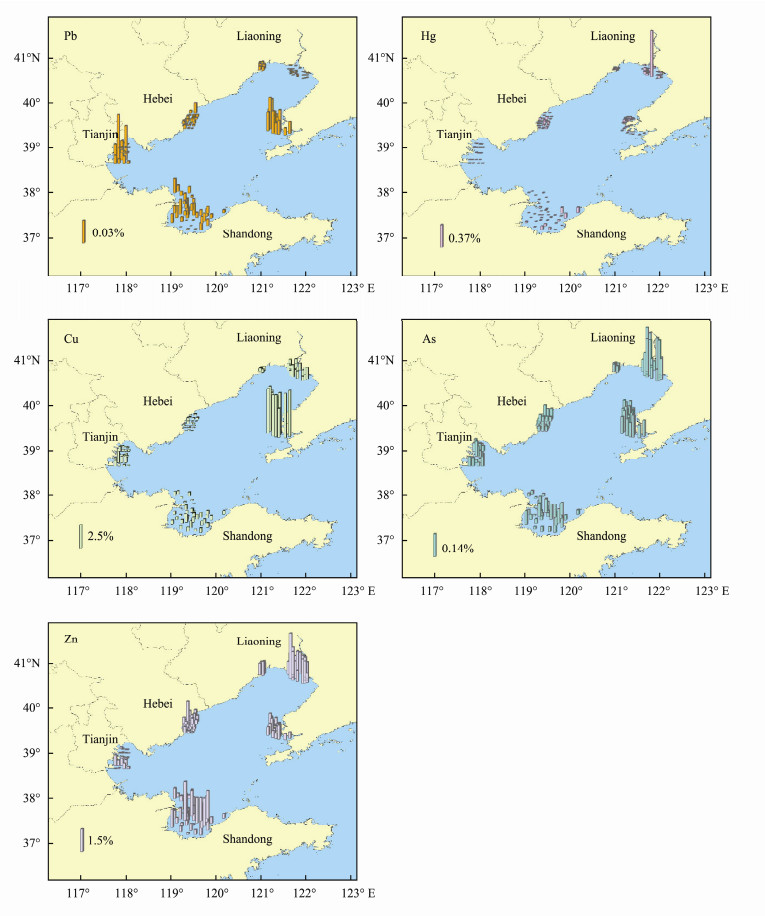
|
Fig. 5 Comparison of ecological risks faced by all of the selected organisms induced by five metals (Pb, Hg, Cu, As and Zn) in the surface seawater of six coastal regions of Boahi Sea. |
The single ecological risks induced by Cu, Zn, Pb, Hg and As in the surface seawater to each group of species (crustacean, fish and mollusc) were evaluated the SSD method for seven coastal region (Changxingdao Island, Shuangtaizi Estuary, Jinzhou Bay, Luanhekou Estuary, Bohai Bay, Yellow River Estuary and Laizhou Bay) of the Bohai Sea (Fig. 6). For crustacean, fish and mollusc, the metals posing the highest ecological risks were similar. For crustacean, the metal with the highest ecological risk was Cu, and followed by Zn and Pb. For fish and mollusc, the metals with the highest ecological risk were Zn and Cu, respectively. The ecological risks with Cu varied significantly among different organisms, among which crustacean and mollusc had higher ecological risks. It should be noted that the proportion of affected mollusc and crustacean from certain sites by Cu in Changxingdao Island were even higher than 5%, which indicated Cu had toxic effects in the ecosystem. The proportion of sites with high ecological risks by Cu to mollusk was up to 70% (19/27), which highlight the urgent need to make great efforts to control the severe metal pollution in Changxingdao Island. However, the ecological risks by Cu to fish could be neglected. The ecological risks with Zn to organisms were all below 2%. The ecological risks by Pb, Hg and As were low due to their lowest concentrations in the surface seawater.
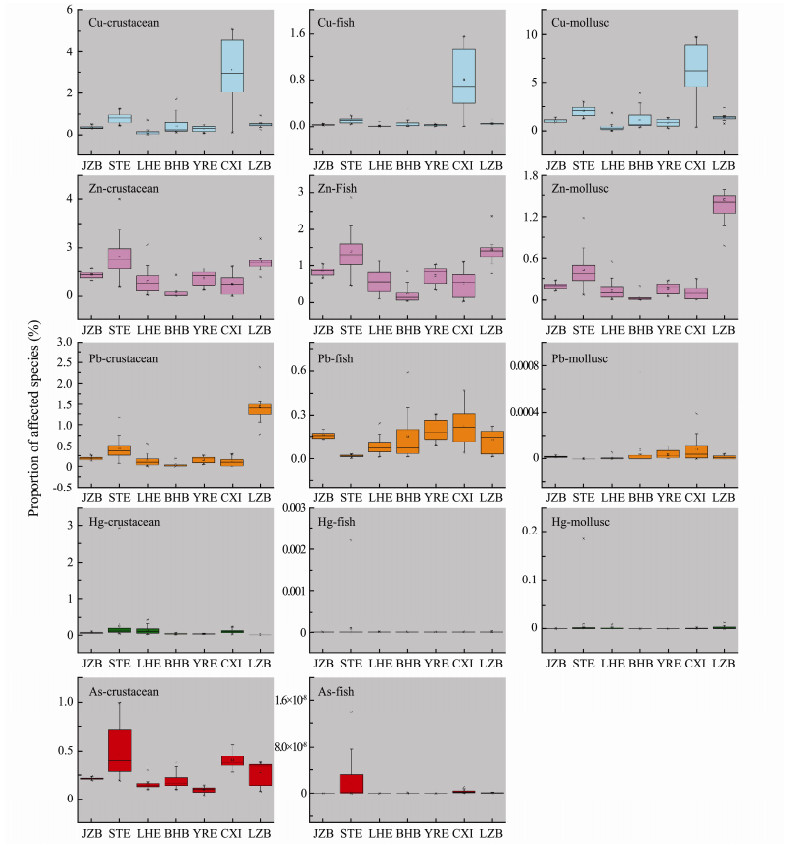
|
Fig. 6 Ecological risks of Cu, Zn, Pb, Hg and As in the surface seawater of seven coastal regions in Bohai Sea to crustacean, fish and mollusc. JZB, Jinzhou Bay; STE, Shuangtaizi Estuary; LHE, Luanhekou Estuary; BHB, Bohai Bay; YRE, Yellow River Estuary; CXI, Changxingdao Island; and LZB, Laizhou Bay. |
In general, the combined ecological risk was low in the coastal Bohai Sea, with significant variances of combined ecological risks among different regions (Fig. 7). Most of the sites had the proportion of affected species below 3%, and high ecological risk sites (the proportion of affected species > 5%) distributed in Changxingdao Island. The combined ecological risks by metals decreased in the following order: Changxingdao Island > Shuangtaizi Estuary > Laizhou Bay > Jinzhou Bay > Yellow River Estuary > Luanhekou Estuary > Bohai Bay. It should be noted that the ecological risk associated with metals was low, which is in accord with the conclusion of metals in the sediment of Laizhou Bay and Shuangtaizi Estuary (Gao et al., 2013; Yang et al., 2015). Gao et al. (2014) evaluated the status of metal contamination in the Bohai Sea based on a comprehensive review, and found Bohai Bay seemed to be the most anthropogenically influenced considering the highest concentrations of As, Cr, Pb and Zn in the surface seawater.
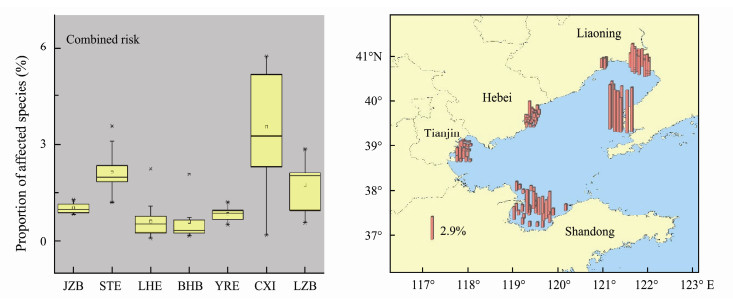
|
Fig. 7 Combined ecological risks of metals in the surface seawater of seven coastal regions around Bohai Sea. JZB, Jinzhou Bay; STE, Shuangtaizi Estuary; LHE, Luanhekou Estuary; BHB, Bohai Bay; YRE, Yellow River Estuary; CXI, Changxingdao Island; and LZB, Laizhou Bay. |
The Bohai Sea has been considered as the most polluted region in China. Industrial and domestic sewage discharges is one of the most important resources contributing to the coastal Bohai Sea. Comprehensive investigation of pollution status is an urgent need for effective protection of the Bohai Sea. In this study, seven coastal regions were investigated, and the concentrations of nutrients (DIN and DIP) and metals (Cd, Pb, Zn, Cu, Cr, As and Hg) in the surface seawater were measured. The status of eutrophication was serious in the Bohai Bay and Shuangtaizi Estuary, and DIN was the main pollutant in the coastal Bohai Sea. The combined ecological risk induced by metals was low in the coastal Bohai Sea, with hotspot regions. Most of the sites had the proportion of affected species below 3%, and high ecological risk sites (the proportion of affected species > 5%) distributed in Changxingdao Island.
AcknowledgementThis study was supported by grant from the National Natural Science Foundation of China (No. 31572595).
de Vries, P., Tamis, J.E., Murk, A.J. and Smit, M.G.D., 2008. Development and application of a species sensitivity distribution for temperature-induced mortality in the aquatic environment. Environmental Toxicology and Chemistry, 27: 2591-2598. DOI:10.1897/08-056.1 (  0) 0) |
El-Sorogy, A.S. and Attiah, A., 2015. Assessment of metal contamination in coastal sediments, seawaters and bivalves of the Mediterranean Sea coast, Egypt. Marine Pollution Bulletin, 101: 867-871. DOI:10.1016/j.marpolbul.2015.11.017 (  0) 0) |
Gao, X., Li, P. and Chen, C.T.A., 2013. Assessment of sediment quality in two important areas of mariculture in the Bohai Sea and the northern Yellow Sea based on acid-volatile sulfide and simultaneously extracted metal results. Marine Pollution Bulletin, 72(1): 281-288. (  0) 0) |
Gao, X., Zhou, F. and Chen, C.T.A., 2014. Pollution status of the Bohai Sea:An overview of the environmental quality assessment related trace metals. Environment International, 62: 12-30. DOI:10.1016/j.envint.2013.09.019 (  0) 0) |
Grasshoff, P., 1983. Methods of Seawater Analysis. Verlag Chemie.FRG, 419: 61-72. (  0) 0) |
He, W., Qin, N., Kong, X.Z., Liu, W.X., Wu, W.J., He, Q.S., Yang, C., Jiang, Y.J., Wang, Q.M., Yang, B. and Xu, F.L., 2014. Ecological risk assessment and priority setting for typical toxic pollutants in the water from Beijing-Tianjin-Bohai area using Bayesian matbugs calculator (BMC). Ecological Indicators, 45: 209-218. DOI:10.1016/j.ecolind.2014.04.008 (  0) 0) |
Ladakis, M., Dassenakis, M., Scoullos, M. and Belias, C., 2007. The chemical behaviour of trace metals in a small, enclosed and shallow bay on the coast of Attika, Greece. Desalination, 213: 29-37. DOI:10.1016/j.desal.2006.05.055 (  0) 0) |
Li, H.J., Gao, X.L., Gu, Y.B., Wang, R.R., Xie, P.F., Liang, M., Ming, H.X. and Su, J., 2018. Comprehensive large-scale investigation and assessment of trace metal in the coastal sediments of Bohai Sea. Marine Pollution Bulletin, 129: 126-134. DOI:10.1016/j.marpolbul.2018.02.022 (  0) 0) |
Li, H.J., Ye, S., Ye, J.Q., Fan, J.F., Gao, M.L. and Guo, H., 2017. Baseline survey of sediments and marine organisms in Liaohe Estuary:Heavy metals, polychlorinated biphenyls and organochlorine pesticides. Marine Pollution Bulletin, 114: 555-563. DOI:10.1016/j.marpolbul.2016.09.002 (  0) 0) |
Li, X.Y., Liu, L.J., Wang, Y.G., Luo, G.P., Chen, X., Yang, X.L., Gao, B. and He, X.Y., 2012. Integrated assessment of heavy metal contamination in sediments from a coastal industrial basin, NE China. PLoS One, 7: e39690. DOI:10.1371/journal.pone.0039690 (  0) 0) |
Lin, C.L., Su, J.L., Xu, B.R. and Tang, Q.S., 2001. Long-term variations of temperature and salinity of the Bohai Sea and their influence on its ecosystem. Progress in Oceanography, 49: 7-19. DOI:10.1016/S0079-6611(01)00013-1 (  0) 0) |
Lin, Y., Fan, J., Wen, Q., Liu, S. and Li, B., 2016. Primary exploration of ecological theories and technologies for delineation of ecological redline zones. Acta Ecologica Sinica, 36: 1244-1252. (  0) 0) |
Lv, D.W., Zheng, B., Fang, Y., Shen, G. and Liu, H.J., 2015. Distribution and pollution assessment of trace metals in seawater and sediment in Laizhou Bay. Chinese Journal of Oceanology and Limnology, 33: 1053-1061. DOI:10.1007/s00343-015-4226-3 (  0) 0) |
Mandich, M., 2018. Ranked effects of heavy metals on marine bivalves in laboratory mesocosms:A meta-analysis. Marine Pollution Bulletin, 131: 773-781. DOI:10.1016/j.marpolbul.2018.04.068 (  0) 0) |
Manfra, L. and Accornero, A., 2005. Trace metal concentrations in coastal marine waters of the central Mediterranean. Marine Pollution Bulletin, 50: 686-692. DOI:10.1016/j.marpolbul.2005.02.044 (  0) 0) |
Naser, H.A., 2013. Assessment and management of heavy metal pollution in the marine environment of the Arabian Gulf:A review. Marine Pollution Bulletin, 72: 6-13. DOI:10.1016/j.marpolbul.2013.04.030 (  0) 0) |
Newman, M.C., Ownby, D.R., Mézin,, L.C.A.,, Powell, D.C., Christensen, T.R.L., Lerberg, S.B. and Anderson, B.A., 2000. Applying species-sensitivity distributions in ecological risk assessment:Assumptions of distribution type and sufficient numbers of species. Environmental Toxicology and Chemistry, 19: 508-515. (  0) 0) |
Ning, X., Lin, C., Su, J., Liu, C., Hao, Q., Le, F. and Tang, Q., 2010. Long-term environmental changes and the responses of the ecosystems in the Bohai Sea during 1960–1996. Deep Sea Research Part II:Topical Studies in Oceanography, 57: 1079-1091. DOI:10.1016/j.dsr2.2010.02.010 (  0) 0) |
Norton, S.B., Rodier, D.J., van der Schalie, W.H., Wood, W.P., Slimak, M.W. and Gentile, J.H., 1992. A framework for ecological risk assessment at the EPA. Environmental Toxicology and Chemistry, 11: 1663-1672. DOI:10.1002/etc.5620111202 (  0) 0) |
Pan, K. and Wang, W.X., 2012. Trace metal contamination in estuarine and coastal environments in China. Science of the Total Environment, 421: 3-16. (  0) 0) |
Peng, S., 2015. The nutrient, total petroleum hydrocarbon and heavy metal contents in the seawater of Bohai Bay, China:Temporal-spatial variations, sources, pollution statuses, and ecological risks. Marine Pollution Bulletin, 95: 445-451. DOI:10.1016/j.marpolbul.2015.03.032 (  0) 0) |
Sharples, J., Middelburg, J.J., Fennel, K. and Jickells, T.D., 2017. What proportion of riverine nutrients reaches the open ocean?. Global Biogeochemical Cycles, 31: 39-58. DOI:10.1002/2016GB005483 (  0) 0) |
Tang, A.K., Liu, R.H., Ling, M., Xu, L.Q. and Wang, J.Y., 2010. Distribution characteristics and controlling factors of soluble heavy metals in the Yellow River Estuary and adjacent sea. Procedia Environmental Sciences, 2(1): 1193-1198. (  0) 0) |
Wan, L., Wang, N.B., Li, Q.B., Zhou, Z.C., Sun, B., Xue, K., Ma, Z.Q., Tian, J. and Du, N., 2008. Estival distribution of dissolved metal concentrations in Liaodong Bay. Bulletin of Environmental Contamination and Toxicology, 80: 311-314. DOI:10.1007/s00128-008-9376-y (  0) 0) |
Wang, J., Liu, R.H., Yu, P., Tang, A.K., Xu, L.Q. and Wang, J.Y., 2012. Study on the pollution characteristics of heavy metals in seawater of Jinzhou Bay. Procedia Environmental Sciences, 13(3): 1507-1516. (  0) 0) |
Wang, M., Tong, Y., Chen, C., Liu, X., Lu, Y., Zhang, W., He, W., Wang, X., Zhao, S. and Lin, Y., 2018. Ecological risk assessment to marine organisms induced by heavy metals in China's coastal waters. Marine Pollution Bulletin, 126: 349-356. DOI:10.1016/j.marpolbul.2017.11.019 (  0) 0) |
Wang, S., Xu, X., Sun, Y., Liu, J. and Li, H., 2013. Heavy metal pollution in coastal areas of South China:A review. Marine Pollution Bulletin, 76: 7-15. DOI:10.1016/j.marpolbul.2013.08.025 (  0) 0) |
Wang, X., Cui, Z., Guo, Q., Han, X. and Wang, J., 2009. Distribution of nutrients and eutrophication assessment in the Bohai Sea of China. Chinese Journal of Oceanology and Limnology, 27: 177. DOI:10.1007/s00343-009-0177-x (  0) 0) |
Wang, Y., Liang, L., Shi, J. and Jiang, G., 2005. Study on the contamination of heavy metals and their correlations in mollusks collected from coastal sites along the Chinese Bohai Sea. Environment International, 31: 1103-1113. DOI:10.1016/j.envint.2005.02.005 (  0) 0) |
Wheeler, J.R., Grist, E.P.M., Leung, K.M.Y., Morritt, D. and Crane, M., 2002. Species sensitivity distributions:Data and model choice. Marine Pollution Bulletin, 45: 192-202. DOI:10.1016/S0025-326X(01)00327-7 (  0) 0) |
Yang, X., Yuan, X., Zhang, A., Mao, Y., Li, Q., Zong, H. and Li, X., 2015. Spatial distribution and sources of heavy metals and petroleum hydrocarbon in the sand flats of Shuangtaizi Estuary, Bohai Sea of China. Marine Pollution Bulletin, 95(1): 503-512. (  0) 0) |
Yang, X., Zhang, P., Li, W., Hu, C., Zhang, X. and He, P., 2018. Evaluation of four seagrass species as early warning indicators for nitrogen overloading:Implications for eutrophic evaluation and ecosystem management. Science of the Total Environment, 635: 1132-1143. DOI:10.1016/j.scitotenv.2018.04.227 (  0) 0) |
Zhang, A., Wang, L., Zhao, S., Yang, X., Zhao, Q., Zhang, X. and Yuan, X., 2017. Heavy metals in seawater and sediments from the northern Liaodong Bay of China:Levels, distribution and potential risks. Regional Studies in Marine Science, 11: 32-42. DOI:10.1016/j.rsma.2017.02.002 (  0) 0) |
Zhang, J., Yu, Z.G., Raabe, T., Liu, S.M., Starke, A., Zou, L., Gao, H.W. and Brockmann, U., 2004. Dynamics of inorganic nutrient species in the Bohai seawaters. Journal of Marine Systems, 44: 189-212. DOI:10.1016/j.jmarsys.2003.09.010 (  0) 0) |
Zhang, Y.M., Zhang, S.F., Song, C.Y. and Wu, K.J., 2014. Numerical simulation of water exchange characteristics in Bohai Sea based on particle tracing method. Marine Environment Science, 33: 412-417. (  0) 0) |
Zhang, Z., Zhu, M., Wang, Z. and Wang, J., 2006. Monitoring and managing pollution load in Bohai Sea, PR China. Ocean & Coastal Management, 49: 706-716. (  0) 0) |
Zheng, X., Zang, W., Yan, Z., Hong, Y., Liu, Z., Yi, X., Wang.,, X, ., Liu, T. and Zhou, L., 2015. Species sensitivity analysis of heavy metals to freshwater organisms. Ecotoxicology, 24: 1621-1631. DOI:10.1007/s10646-015-1500-2 (  0) 0) |
 2020, Vol. 19
2020, Vol. 19


